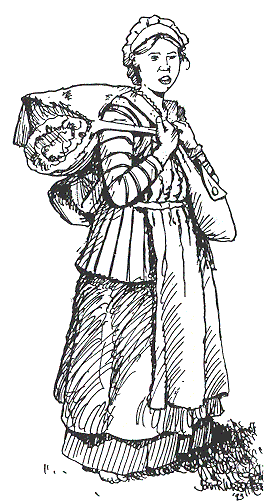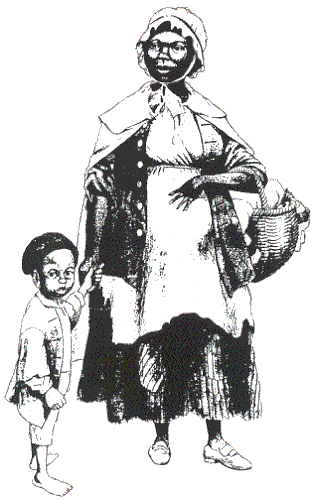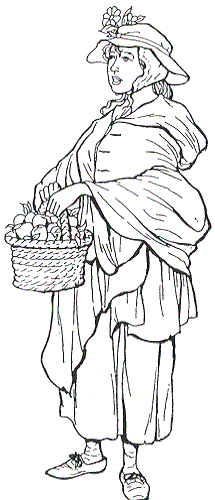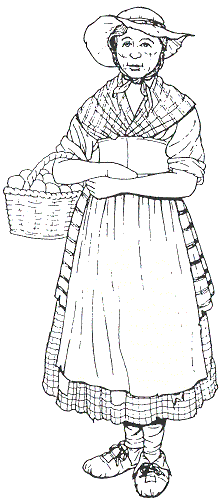Though women were commonly seen with armies in the 18th century, there are few descriptions of how they looked. No matter what country they came from, the wives, children, and consorts of common soldiers can be grouped together as being of the poorer classes of society. The following documents illustrate some of the clothing worn by females who followed the British and American armies, and the contingent of German troops serving the Crown.
First we will look at the wife of a British soldier who, through misfortune, comes to our attention more than two hundred and twenty years later. As a follower attached to a British regiment, Ann Miller was present only at the pleasure of the unit commanders and would have been required to live under military law, making herself useful to the regiment. Although her regiment was in a stationary situation she had to be prepared to follow the regiment on its travels at a moments notice. Assuming that Ann Miller was telling the truth about her losses, the inventory below is interesting as it shows what was probably a large portion of the personal goods belonging to a largely unpropertied and itinerant woman.
A "List of Cloaths taken from Ann Miller of the Roy. Fuzileers
at La Parara in Canada,"
Lancaster, Pennsylvania, 13 February 17761
L S d 2 Gounds Value ----------- 2 - 0 - 0 1 Black Cloke ------------ 1 - 0 - 0 1 Silk Hatt -------------- 0 - 8 - 0 1 Peticote --------------- 0 - 7 - 6 4 Aprons ----------------- 0 - 12 - 0 1 Pair of Stays ---------- 0 - 12 - 0 3 Shifts ----------------- 0 - 12 - 0 Childrens Cloaths -------- 2 - 0 - 0 1 Bead Tick & 2 Pillows -- 0 - 11 - 0 To provide some context, a detachment of the 7th Regiment, Royal Fusiliers (eighty-eight officers and men, thirty women, and fifty-one children), had been captured at Chambly on 17 October 1775, and eventually sent south to the barracks at Trenton, New Jersey.2
Also submitted about the same time as Mrs. Miller's list was a "Return of Cloathing Necessarys &ca that was lost belonging to the Prisoners of His Majestys 7th Regt or Royal Fuzileers at Trenton." This document contains the names of nineteen soldiers who lost among them numbers of gaiters, hats, "Fir Gloves," coats, breeches, shirts, neck "Stocks or Rollers," shoes, hose and "Winter Capps," these last probably Canadian caps. Private Jonathan Miller, probably husband of Ann, lost his coat, neck stock, and a pair of breeches and hose. The listing includes the cost of the missing apparel which "were Valued by the Serjeants there is likewise a Whole Years Cloathing lost."3
By comparison the belongings of Mrs. McQueen of the 84th Regiment, Royal Highland Emigrants, were inventoried after her death, circa 1780, and included,
2 blankets, 4 paticoats, 4 shifts, 3 short gown, 1 pair stockings, 1 pair shoes, 1 apron, 1 coat, 1 waistcoat, 2 shirts.
Mrs. McQueen died in Halifax, Nova Scotia, or somewhere in the southern states, elements of the regiment serving in both places at the time. The man's coat and waistcoat she owned are notable; soldiers' families in the 84th at Quebec in 1777 were given "suits of clothing complete, hatts, mocasins, legging cloth, linen yards, Canadian shoes, [and] stockings." Some of this clothing was obviously men's apparel, implying that female followers commonly wore items of male clothing.4
Next we have two narratives concerning camp followers with German troops under General John Burgoyne in 1777 as they appeared after their surrender at Saratoga, New York. Militia private Daniel Granger described the Convention troops immediately after the surrender, including one distinctive (to him) part of the women's apparel: "... soon the Van of the Prisoners made their appearance, The Hesson Troops came first with their baggage on Horses... These Troops had some Women, who wore short Petty coats, bare footed, & bare Leged, with huge Packs on their backs, some carrying a child & leading an other or two, They were silent, civil, and looked quite subdued."5
A woman in Boston gave this description, interesting as much for the information corroborating Granger's account as for additional details. "As the German prisoners marched through Cambridge, Massachusetts they were accompanied by 'great numbers of women, who seemed to be the beasts of burthen, having a bushel basket on their back, by which they were bent double, the contents seemed to be Pots and Kettles, various sorts of Furniture, children peeping thro' gridirons and other utensils, some very young Infants who were born on the road, the women bare feet, cloathed in dirty rags ...'"6
Camp follower in marching order.
Illustration by John R. Wright, courtesy of the artist.Finally, let's look at some women with the Continental Army. The following is excerpted from an upcoming article by the author entitled, "'The number of rations issued to the women in camp.': New Material Concerning Female Followers With Continental Regiments."
What kind of women were these who would choose, or be forced by circumstances, to follow the army under very trying conditions? There are few first-hand descriptions of American camp followers available, but with what little we do have it seems that they were a mixed lot indeed. Maria Cronkite was the wife of a musician in the 1st New York Regiment and seems to have been quite well respected. She was thirty-two years old when she followed her husband into the army in 1777. Mrs. Cronkite served 'in the capacity of washerwoman for the officers until the close of the war where her husband was duly discharged ... [and] had while in said service several children...' As might be expected in an army where black soldiers were a substantial minority, camp followers included at least a few women of color. In an October 1778 runaway advertisement, the colonel of the 3rd Maryland Regiment described a 'MULATTO slave, named Sarah, but since calls herself Rachael; she took her son with her, a Mulatto boy named Bob, about six years old, has a remarkable fair complexion, with flaxen hair: She is a lusty wench, about 34 years old, big with child; had on a striped linsey petticoat, linen jacket, flat shoes, a large white cloth cloak, and a blanket, but may change her dress, as she has other cloaths with her. She was lately apprehended in the first Maryland regiment, where she pretends to have a husband, with whom she has been the principal part of this campaign, and passed herself off as a free woman.Ē7
18 October 1778: "RUN-AWAY ... a likely MULATTO slave, named Sarah,
but since calls herself Rachael; she took her son with her,
a Mulatto boy named Bob, about six years old ...
She was lately apprehended in the first Maryland regiment,
where she pretends to have a husband,
with whom she has been the principal part of this campaign,
and passed herself off as a free woman."
Runaway advertisement, The Brigade Dispatch, vol. X, no. 4 (Sept./Oct. 1974), 15.
Illustration by Peter F. Copeland, courtesy of the artist.For an unflattering view of the army's followers, this time on the move in 1780, we turn to Joseph Plumb Martin. Although women are not specifically mentioned in his account their presence is inferred. After being separated from his unit Martin 'had an opportunity to see the baggage of the army pass. When that of the middle states passed us, it was truly amusing to see the number and habiliments of those attending it; of all specimens of human beings, this group capped the whole. A caravan of wild beasts could bear no comparison with it. There was "Tag Rag and Bobtail"; "some in rags and some in jags," but none "in velvet gowns." [author's emphasis] Some with two eyes, some with one, and some, I believe, with none at all ... their dialect, too, was as confused as their bodily appearance was odd and disgusting. There was the Irish and Scotch brogue, murdered English, flat insipid Dutch and some lingoes which would puzzle a philosopher ... I was glad to see the tail end of the train ..."8
Some insight into how camp followers replaced worn-out clothing may be useful. Several attempts were made by the government or army to procure clothing for the women. In autumn 1778 the U.S. Board of War recommended that when a shipment of new clothes was issued, the soldiers' old clothing be collected and a part given to "the followers of the Army." This plan was never realized as George Washington decided to "let the matter drop" when he learned the troops "looked upon it as an unjustifiable attempt to deprive them of what they had earned by their years service ..." Two years later, attempting to mollify Pennsylvania soldiers after their January 1781 mutiny, Joseph Reed recommended that the Council of Pennsylvania, "take some notice of their women and children by providing some decent clothing, which they have not at present. There are about 100 of them, and, like ourselves, they have their attachments and affections. A new gown, silk handkerchief, and a pair of shoes, &c., would be but little expense, and I think as a present from the State would have more effect than ten times the same laid out in articles for the men." The clothing was to be "given only to those soldiers' wives who continue in the service."9
Woman in working dress, wearing a manís felt hat, surtout coat, and linen apron over her skirt.
A good representation of a camp follower.
On a march old knapsacks, linen wallets, or sacks would more likely be used
to carry necessaries; baskets would be tedious to carry and hold few belongings.
Peter F. Copeland, Working Dress in Colonial and Revolutionary America
(Westport, Ct. and London: Greenwood Press, 1977), 48.Female followers likely made their own clothing when materials were available. This can be inferred from knowledge that common soldiers occasionally found time, and had the expertise, to sew clothing for themselves. Sergeant Jeremiah Greenman writing between 6-11 March 1778, noted, "Implying my Self in making a westcoat." In 1781, while a prisoner of the British, Greenman, now a lieutenant, made a quantity of clothing. 22 May, "... got a pair of overhalls cut out, then returned to my Quaters & implyed myself Remainder of the day." 23 May, "Implying myself in making my overalls." 24-25 May, "... made a pair of Socks." 31 May, "... made a Linning Vest with the assi[s]tance of my Land la[d]y." 8 June, "... implying myself in making two linning night Caps." Some soldiers also were skilled at a craft, which they found leisure time to ply. Massachusetts soldier Nahum Parker made a number of pairs of shoes in 1780. The day before he joined the army he wrote, "Wednesday 5 [July] I made a pair of shoes." Later in the year, while with Washington's army, at or near Tappan, New York, he made a number of such entries. A few examples: "Sunday 24 [September] ... I made A pare of Mogosons and Mended my shoes / God forgive me." "27 [October] I made A pare of womens shoes." "2 [November] I finished A pare of Boots ..." "November Tuesday 7th 1780 ... I begun A Pare of Shoes for A Woman." "Wednesday 8† I finished the shoes ..." It is probable the woman's shoes were for an army retainer.10
In summation, besides their common connection with lower levels of the social strata, these women had diverse experiences. Their background may have dictated kinds of clothing they preferred or were familiar with, but the vagaries of war affected what was available to them, often resulting in shortages and hardship. Ann Miller may have owned a lot of clothing for one in her situation, but she can be compared to Sarah, the American follower, who besides "a striped linsey petticoat, linen jacket, flat shoes, a large white cloth cloak, and a blanket," had "other cloaths with her." Ann Miller was coming from what had been a peacetime military establishment shortly before her capture; Sarah had probably acquired her clothing while living with her former master, though she may have added to her belongings while with the army. Mrs. McQueen's clothing inventory represented all the belongings she owned, but it is not known whether she was serving in garrison or with the moving army. The German women show another side of military life. After leaving Canada with Burgoyne's army, they had marched long distances through rough country, in difficult conditions. They may have started off well-shod, well-clad, and in good spirits, but an arduous campaign had left them with "bare feet, cloathed in dirty rags," and probably wishing they had never joined the army at all.
Another example of the rough, utilitarian clothing likely worn by army camp followers;
round felt hat, kerchief, shawl, coarse linen apron, woolen stockings, and moccasins.
Peter F. Copeland, Working Dress in Colonial and Revolutionary America
(Westport, Ct. and London: Greenwood Press, 1977), 99.References
For further reading on British, German, and American female followers in the War for Independence see:
Walter Hart Blumenthal, Women Camp Followers of the American Revolution (New York, 1974), "British Camp Women on the Ration", pp. 15-54. "American Camp Women Under Washington", pp. 57-90.
Todd W. Braisted, "Refugees & Others: Loyalist Families in the American War for Independence," The Brigade Dispatch (Journal of the Brigade of the American Revolution), two parts: vol. XXVI, no. 4 (Winter 1996), pp. 2-7; vol. XXVII, no. 2 (Summer 1997), pp. 2-6.
Bruce Burgoyne, "Women with the Hessian Auxiliaries during the American Revolutionary War," The Brigade Dispatch, three parts: vol. XXVI, no. 1 (Spring 1996), pp. 2-8; vol. XXVI, no. 2 (Summer 1996), pp. 6-16; vol. XXVI, no. 3 (Autumn 1996), pp. 19-23.
Bruce Burgoyne, "Women with Hessian Military Units," The Brigade Dispatch, vol. XXVI, no. 3 (Autumn 1996), pp. 2-10.
Don N. Hagist, "The Women of the British Army, A General Overview. Part 1 - Who & How Many," The Brigade Dispatch, vol. XXIV, no. 3 (Summer 1993), pp. 2-10; "Part 2 - Sober, Industrious Women," vol. XXIV, no. 4 (Autumn 1993), pp. 9-17; "Part 3 - Living Conditions," vol. XXV, no. 1 (Spring 1995), pp. 11-16; "Part 4 - Lives of Women and Children," vol. XXV, no. 2 (Summer 1995), pp. 8-14.
Paul E. Kopperman, "The British High Command and Soldiers' Wives in America, 1755-1783", Journal of the Society for Army Historical Research, no. 60 (1982), pp. 14-34.
Holly A. Mayer, Belonging to the Army: Camp Followers and Community during the American Revolution (Columbia, S.C., 1996)
John U. Rees, "'... the multitude of women': An Examination of the Numbers of Female Camp Followers with the Continental Army," The Brigade Dispatch, three parts: vol. XXIII, no. 4 (Autumn 1992), pp. 5-17; vol. XXIV, no. 1 (Winter 1993), pp. 6-16; vol. XXIV, no. 2 (Spring 1993), pp. 2-6. (Reprinted in Minerva: Quarterly Report on Women and the Military, vol. XIV, no. 2
John U. Rees, "'... the number of rations issued to the women in camp.': New Material Concerning Female Followers With Continental Regiments," (to be published in The Brigade Dispatch (Journal of the Brigade of the American Revolution))



